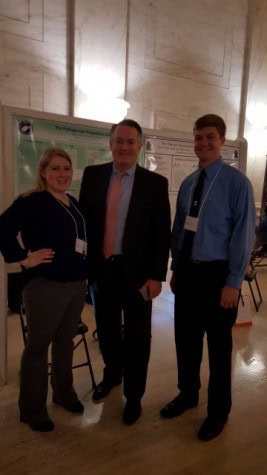
By DEMIAN NUNEZ
(THE PICKET)- On February 25th, Shepherd CME students Emilie Piatek and Bradley Davidson presented their project titled The Pythagorean Proposition Project at West Virginia’s 13th annual Undergraduate Research Day at the Capitol in Charleston.
The goal of their ongoing two-year project is to break down over 370 mathematical proofs for the Pythagorean proposition, and distill them into a more understandable form for teachers and those less mathematically inclined to access on the internet.
The Pythagorean proposition, or theorem, as it is also widely known, states that the sum of the squares of a right triangle’s two shortest sides, or “legs” is equal to the square of the longest side, or hypotenuse. For the past two and a half millennia, there have been countless proofs of this concept illustrated around the world independently coming to the same conclusion.
“It’s cool how different parts of the world came to the same conclusion in different ways,” remarked Piatek, a senior industrial math major seeking a career in industrial engineering after graduation. Piatek was awarded the NASA Space Consortium Grant her sophomore year to help fund the project.
“We dissect the proofs to the point that someone who’s not mathematically inclined can understand them…my roommate who didn’t like math at all my sophomore year when I was doing this, she could understand the proofs and get excited about it, even when she didn’t need to care about it. It reaches out to people who might not otherwise be engaged in mathematics,” Piatek added.
Bradley Davidson, a junior secondary education major concentrating in mathematics, sees great potential in their work as a future tool that he can use to teach his own students one day.

“It’s really an interesting project for me as a math education major, because I can actually see here that abstractness of what Loomis has written in the book, and then be able to take all the ideas of explaining things in written words versus spoken words, versus having a picture. And it also has that kinesthetic part of learning, where I’m linking an interactive picture to it,” said Davidson, regarding how a proof by Elisha S. Loomis appeared on their work-in-progress website’s interactive layout.
The proofs for the Pythagorean proposition can be broken up into four categories: algerbraic, geometric, quaterneonic and dynamic. Algebraic and Geometric are the most common, with algebraic being the harder of the two to disseminate visually to the average person.
“Algebraic proofs are difficult to display visually, because it’s the manipulation of variables to lead to an outcome. But, nonetheless we take and use the visual (on the website) and highlight the sides we’re speaking of, as we speak of it,” Davidson said.
Before populating the website with proofs, the students must first find them and develop a deep enough understanding themselves to accurately present them. Some sources they use include copies of various authors’ own notes they wrote with typewriters over a hundred years ago. This adds a new dimension to the challenge as many of these sources have smudges and some characters are hard to read. “For some of them, I couldn’t discern the plus signs from the division signs, and I spent days trying to figure out how they worked,” Davidson said.
Assistant Professor of Mathematics Karen Adams could only gush with praise about her students, who she said chose to apply to the Undergraduate Research Day at the Capitol themselves.
“The email (forwarded by Piatek) said that the event was highly competitive and the fact two Shepherd students had earned the right to present at a research symposium hosted by WVU and Marshal was really unbelievable,” she said.
Adams is proud of what her students are accomplishing, and believes they deserve the highest praise for their years of work on the project.
“From an instructor’s point of view, this has been one of my most favorite research endeavors with students, because it’s hard to set up undergraduate research, let alone something the students can not only handle on their own, but really, really, love,” Adams said.
Leave a Reply